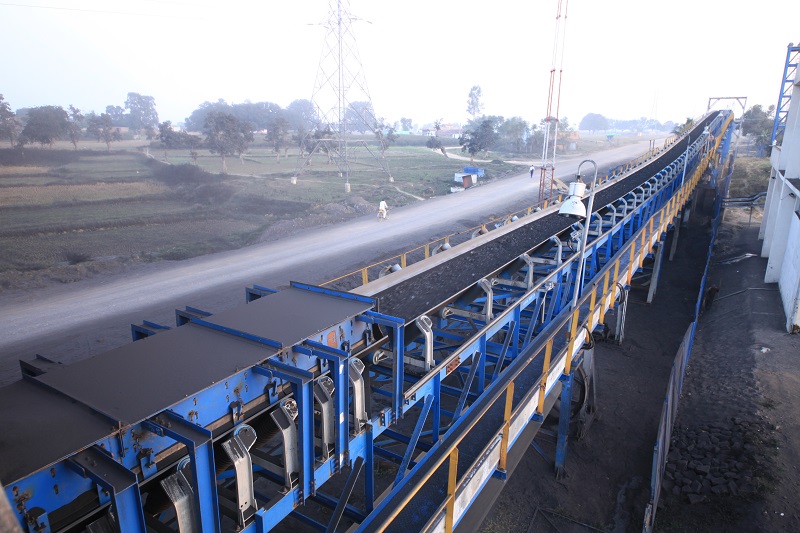Long Distance DTII Belt Conveyor: The Solution for Efficient Material Transport
Long Distance DTII Belt Conveyor
In the world of industrial and logistics operations, efficient material transport over long distances is a critical consideration. When it comes to moving goods, raw materials, or products over extended distances, the choice of conveyor plays a pivotal role in ensuring smooth and cost-effective operations.

Which conveyor is used for long distance?
Among the various conveyor systems available, the DTII belt conveyor has emerged as a go-to solution for long-distance material handling needs.
1. DTII Belt Conveyor Overview:
The DTII belt conveyor is a type of continuous conveyor system that employs a belt made of durable materials like rubber or fabric to transport materials. This conveyor system is known for its robust construction, flexibility, and efficiency, making it well-suited for a wide range of industries, including mining, manufacturing, and logistics.
2. Advantages of DTII Belt Conveyors for Long Distances:
1). Exceptional Efficiency: The DTII belt conveyor is designed to handle large volumes of materials with minimal energy consumption. It provides a continuous and smooth transportation process, reducing the need for manual intervention and optimizing productivity.
2). Cost-Effective: Long-distance transportation can be expensive if not managed efficiently. DTII belt conveyors offer a cost-effective solution by minimizing labor costs and reducing material wastage due to spillage or damage during transport.
3). Low Maintenance: These conveyors are known for their durability and low maintenance requirements. They are designed to withstand the wear and tear associated with long-distance material transport, reducing downtime and maintenance expenses.
4). Versatility: DTII belt conveyors can be customized to meet specific industry requirements. They can handle a wide variety of materials, including bulk goods, aggregates, and even hazardous materials, making them adaptable to diverse applications.
5). Safety: Safety is a top priority in industrial settings. DTII belt conveyors are equipped with safety features, such as emergency stop switches and guarding, to ensure the well-being of workers and the protection of materials being transported.
3. Applications of Long Distance DTII Belt Conveyor:
DTII belt conveyors find applications in various industries, such as:
1). Mining: They are used to transport coal, ores, and other mined materials from the extraction site to processing plants or storage facilities.
2). Manufacturing: These conveyors are employed in manufacturing facilities to move raw materials, components, and finished products between different stages of production.
3). Logistics and Distribution: DTII belt conveyors are essential in distribution centers and warehouses for the efficient movement of packages and goods over long distances.
4). Construction: They play a crucial role in the construction industry for transporting construction materials like sand, gravel, and concrete over extensive job sites.
In the world of material transport, efficiency, reliability, and cost-effectiveness are key factors. The DTII belt conveyor has proven itself as an indispensable tool for handling long-distance material transport needs across various industries. Its exceptional efficiency, low maintenance requirements, and adaptability make it a preferred choice for businesses looking to streamline their operations and ensure the smooth flow of materials over extended distances. As industries continue to evolve and expand, the DTII belt conveyor remains a trusted solution for addressing the challenges of long-distance material transport.
If you want to have a more efficient Long Distance DTII Belt Conveyor, please contact JULI. JULI will solve the problem of long-distance transportation of materials for you.
 O'zbek
O'zbek slovenský
slovenský Azərbaycan
Azərbaycan Қазақ
Қазақ Latine
Latine ລາວ
ລາວ български
български नेपाली
नेपाली فارسی
فارسی Javanese
Javanese Українська
Українська Lietuvos
Lietuvos Română
Română Slovenski
Slovenski پښتو
پښتو Punjabi
Punjabi Bosanski
Bosanski Malti
Malti Galego
Galego Afrikaans
Afrikaans Esperanto
Esperanto 简体中文
简体中文 Српски
Српски मराठी
मराठी Ελληνικά
Ελληνικά čeština
čeština Polski
Polski ไทย
ไทย Nederlands
Nederlands Italiano
Italiano Tiếng Việt
Tiếng Việt Deutsch
Deutsch français
français русский
русский Português
Português Español
Español 한국어
한국어 Svenska
Svenska Malay
Malay اردو
اردو norsk
norsk Indonesia
Indonesia عربى
عربى Gaeilge
Gaeilge Türk
Türk Pilipino
Pilipino हिन्दी
हिन्दी Dansk
Dansk বাংলা
বাংলা English
English


Juli Engineering: A Trusted Supplier of Durable Coal Screw Feeders for Reliable Material Handling
In the fast-evolving industrial sector, efficiency, durability, and reliability are essential in material handling systems. Juli Engineering, a leading Durable Coal Screw Feeder supplier, continues to set industry standards with its high-quality products designed for continuous and precise coal feeding applications. With a reputation for engineering excellence and long-term performance, Juli Engineering provides advanced screw feeder solutions that meet the demanding needs of power plants, mining operations, and industrial production lines.
Read MoreJuli Engineering: A Leading Stacker Reclaimer Machine Supplier Driving Industrial Efficiency
As global industries continue to modernize their bulk material handling systems, Juli Engineering stands out as a trusted stacker reclaimer machine supplier, known for delivering advanced, durable, and high-performance solutions. With a focus on innovation, precision engineering, and long-term reliability, Juli Engineering has established itself as a key player in supporting mining, port, power plant, and steel industries worldwide.
Read MoreJuli Engineering Leads the Industry as a Trusted Belt Conveyor Manufacturer
As global industries continue to modernize production and logistics systems, the demand for durable, efficient, and high-performance material handling equipment has never been greater. Among the key players driving this evolution, Juli Engineering has established itself as a leading name among Belt Conveyor manufacturers, offering innovative solutions that enhance productivity, safety, and operational efficiency across a wide range of sectors.
Read More